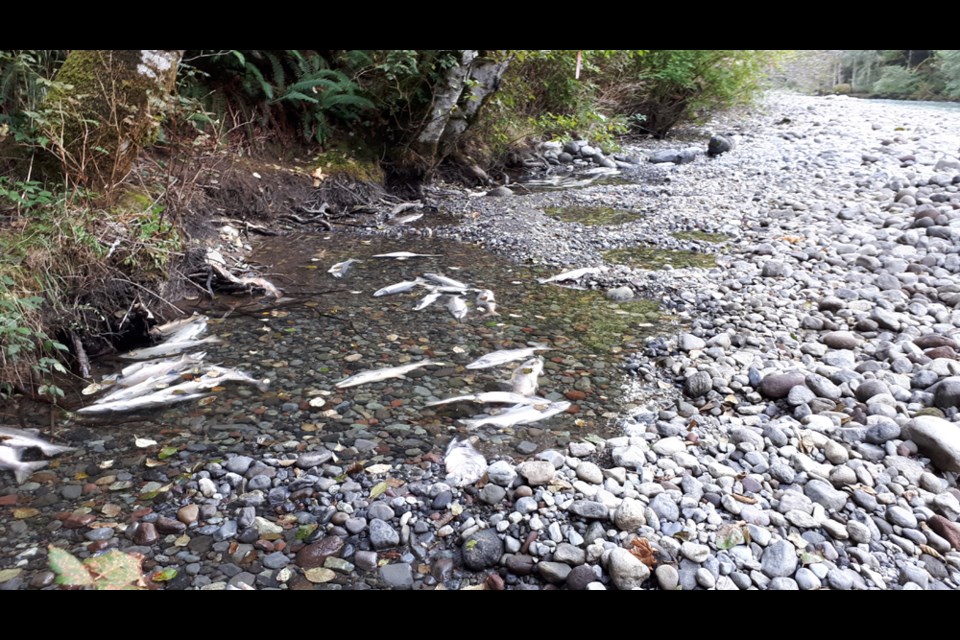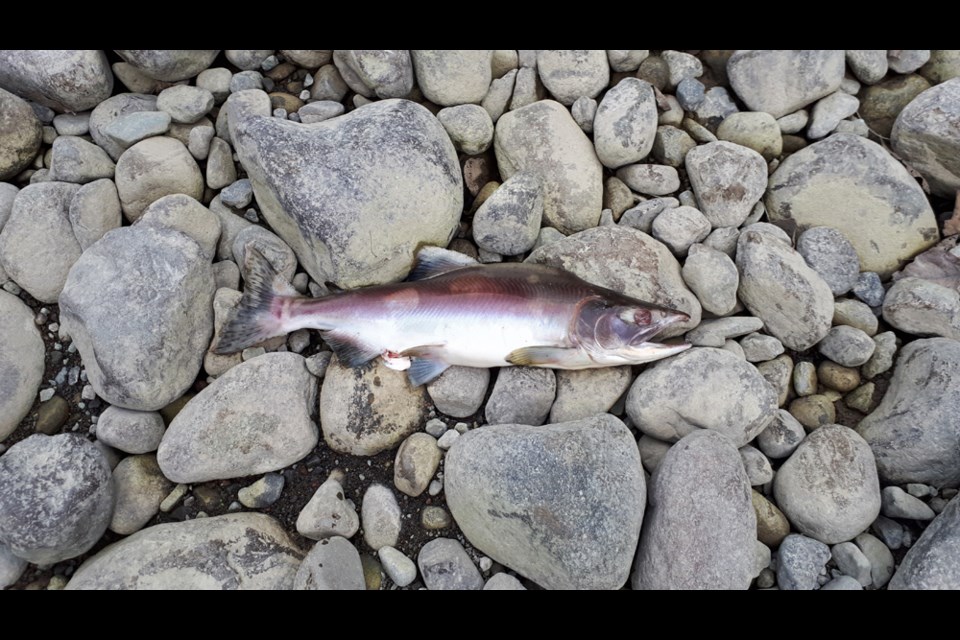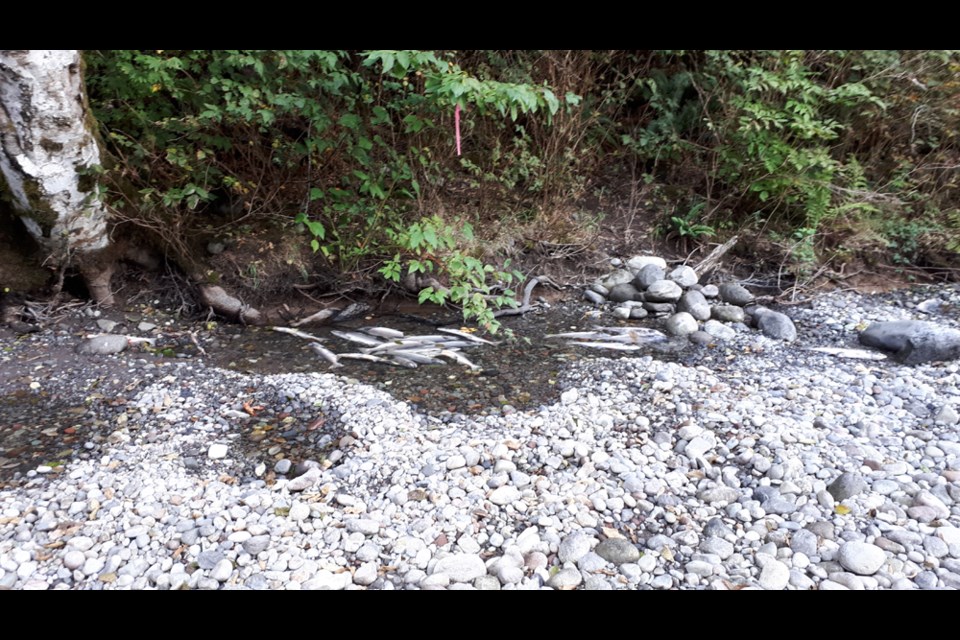Through documents obtained by an Access to Information request of Fisheries and Oceans Canada, and follow up questions to the DFO and BC Hydro, The Chief has learned more about the Sept. 20, 2019, pink salmon kill on the Cheakamus River.
This event caused the death of approximately 3,000 pink spawners, according to Squamish biologist and president of the Squamish River Watershed Society, Chessy Knight.
This wasn't a one-off event. Knight counts about six stranding events in 2018, 2019, that she knows of.
Knight estimates last summer alone, approximately 60,000 steelhead fry died due to BC Hydro ramping activity. That figure does not include estimates for juveniles of other species like coho salmon.
The Sept. 20 stranding happened after BC Hydro cut river flows, following a rain storm.
The documents show that BC Hydro did notify the DFO, as required, on the day of the event.
The "stranding event occurred Sept. 20 as a result of an authorized rampdown out of Daisy Lake Dam on the Cheakamus River. The rampdown was completed in direct response to storm events over the past week that necessitated increased spill to the Cheakamus and subsequent ramp-down," reads the BC Hydro email notification, that was also sent to the BC Ministry of Forests, Lands Natural Resource operations.
In emails between DFO employees, it is raised that there are no compliance issues with BC Hydro's Cheakamus facility.
In other words, the DFO employees are saying BC Hydro is in compliance with the Fisheries Act Authorization for the Sea to Sky facility. This is said on at least two occasions: once on Oct. 2, 2019 and another time Oct. 7, 2019.
This is something Knight takes issue with, considering the pink salmon killed and other similar stranding events.
"Seriously? How many fish can BC Hydro kill before there is a compliance issue?" she asked.
Fish kills in context
The Fisheries Act allows BC Hydro to kill fish, as is widely acknowledged by the Crown corporation, DFO and conservationists, but The Chief asked the DFO if the number of fish strandings and kills in 2018 and 2019 suggest impacts that are way worse than originally projected?
"The issue of fish stranding on the Cheakamus River was not fully understood during the original Water Use Planning process for BC Hydro's Cheakamus Project, but has been subject to more focused assessment and regulatory oversight since that time," reads a statement from DFO.
Water Use Plans is a technical document that defines how water control facilities — like BC Hydro — will be operated. The WUPs are reviewed by provincial and federal agencies and approved by the provincial Comptroller of Water Rights.
The current WUP was accepted by the Comptroller of Water Rights and implemented in February, 2006.
"The authorization includes conditions related to fish stranding, as well as a general provision stipulating that if 'monitoring results and/or other observations indicate that the benefits or impacts to the resource are significantly different from those originally projected, DFO may modify or rescind this authorization.' DFO's current view is that the incidence of fish stranding on the Cheakamus River is greater than previously anticipated, and as such requires that BC Hydro develop appropriate monitoring, mitigation, and offsetting measures to address these impacts. In authorizing existing projects such as this, DFO does not typically specify an allowable number of stranded fish, but rather focuses on avoiding, mitigating, and/or offsetting mortality such that it does not result in population-level effects."
Knight, who was part of the original Water Use Planning process for BC Hydro’s Sea to Sky facility, says "it is not entirely true that the issue of fish stranding was not fully understood during the WUP process. In fact, ramping rates were one of the reasons that the WUP process ended in non-consensus," she told The Chief.
"Cheakamus was the only facility of BC Hydro's 23 WUPs that was unable to reach consensus."
Consultation with the public and the local WUP committee began in February, 1999. After 25 committee meetings, there was a failure to reach consensus.
BC Hydro then drafted a non-consensus WUP and submitted it to the comptroller of water rights.
Video of stranded fish after Sept. 20 ramping event. Courtesy Chessy Knight
Testy relationship
The ATIP documents — which include records and DFO, BC Hydro emails regarding the fish killed due to ramping in Squamish between July and Oct. 15, 2019 — show a lot of back and forth communication deciding on talking points for the media and stakeholders regarding the strandings.
In several other email exchanges, DFO and BC Hydro staff seem to accuse stakeholders like Knight and others in the Sea to Sky of avoiding direct conversations with them on the issue of stranding prior to going to the media.
"Not sure if you are aware of the recent fish stranding on the Cheakamus, made by Chessy and others. There has been much correspondence on this between various stakeholders, which as far as I can tell has regrettably not included BC Hydro," reads one Aug. 21 email from DFO to BC Hydro staff.
In another from DFO to the provincial government:
"It's unfortunately [but not surprising, in this context] that BC Hydro seems to be excluded from the conversation, which is a strategy I generally find to be counter-productive."
Knight says that she and others sent several emails in 2018, well before going to the media, about the fish kills and "got absolutely nowhere with either the regulatory agencies or BC Hydro."
"It was not our original intention to take this issue to the media. BC Hydro and DFO did it to themselves and they blame us for essentially not playing fair."
In one email on Oct. 1, 2019, a BC Hydro environmental specialist states that stakeholders are focusing on fish stranding events because they are upset at BC Hydro not continuing some monitoring programs in the area.
"The two issues are not related at all," says Knight, adding that the implication is "offensive."
"It is offensive because BC Hydro is implying a tit-for-tat," she said. "While stakeholders remain upset that key WUP monitoring programs are cancelled, if there had been no stranding and fish kills, there would be no story about stranding and fish kills. There would be nothing to report."
Action taken after fish kills
In the documents, on Oct. 7, 2019, a fisheries officer with DFO says that Conservation and Protection will be following up with representatives from Indigenous, provincial and community groups about the issue of stranding.
The Chief asked what has been done since this time.
DFO says with BC Hydro it facilitated multi-stakeholder discussions to address the issue of fish stranding due to Cheakamus Project operations, including discussions at the bi-annual Fish-Hydro Management Committee meeting in Vancouver on Oct 7, 2019, the Cheakamus Adaptive Stranding Protocol (CASP) workshop in Squamish on Dec. 5, 2019, a follow-up conference call with BC Hydro about the Cheakamus Stranding on Dec. 17, 2019, and follow-up correspondence by DFO asking BC Hydro for potential compensation for the Sept. 20th stranding losses.
Non-disclosure and the Crown corp
While looking into information in the ATIP documents, The Chief learned that consultants for the Crown corporation are being asked to sign non-disclosure agreements.
"Having consultants sign non-disclosure agreements is a common practice for BC Hydro due to the nature of the work, which often involves proprietary or confidential information," reads a statement from BC Hydro.
Sean Holman, associate professor of journalism at Mount Royal University, told The Chief while many companies are implementing NDAs, that doesn't make it right, especially for a Crown corporation.
"What is disturbing is, increasingly, public sector organizations are closing off every avenue that the public and journalists have to obtain information that they would not otherwise voluntarily release," he said.
Holman says these avenues include restrictive freedom of information laws, obstacles to whistleblowers coming forward, and non-disclosure agreements, as are being implemented by BC Hydro.
"These go against the spirit of democracy because you do not want government, and you do not want public agencies, simply providing information that they voluntarily want to give to the public. You want the public and journalists to have the capacity to get information that they are not voluntarily disclosing, because otherwise, how can we hope to hold these public agencies to account for their behaviour? How can we hold these governments to account for their behavior? That is really what is at stake here."
Fast facts
BC Hydro has an authorization — permission — for its Squamish operation through its Fisheries Act Authorization, which has been extended to Nov. 1, 2024 and BC Hydro told The Chief that the intention is to “seek a long-term authorization from the DFO following the conclusion of the Water Use Plan Order Review process.”
The review aims to determine how water management regulations for BC Hydro’s operations are working for the environment and community. Due to the pandemic, upcoming meetings and consultation in relation to the review have been postponed, according to BC Hydro.
**Please note, this story has been updated since it was first posted. Originally, it read "juveniles or other specie," but should have read "juveniles of other specie."







